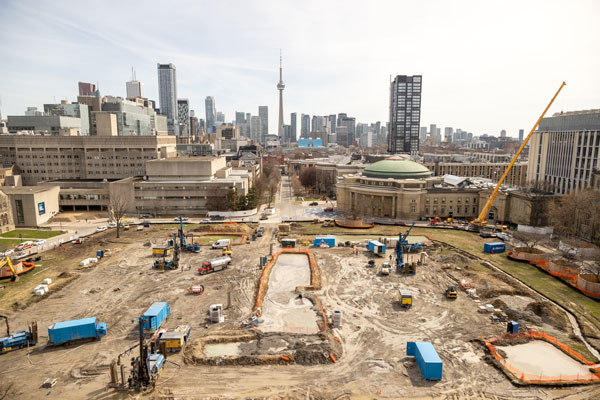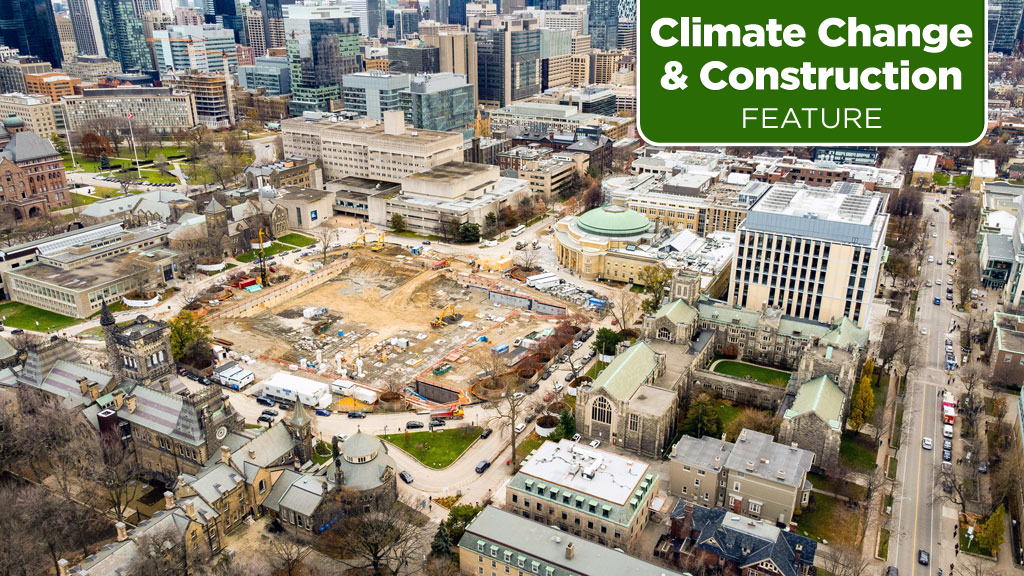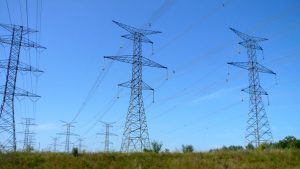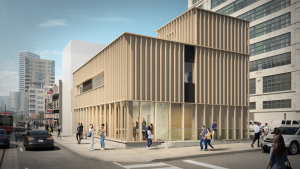Crews are preparing the footings, shoring walls and utilities for a one-level underground parking garage amidst the historic buildings at the downtown St. George campus of the University of Toronto (U of T).
But that’s not the interesting part.
Below the parking garage, crews have bored a field of 370 wells and inserted a series of U-shaped pipes that will be filled with a mixture of glycol and water and linked to a network of heat pumps that will serve the heating and cooling systems in U of T’s existing buildings. Some of the pipes go down 250 metres.
The boreholes will allow for storage of surplus heat generated by mechanical systems in the summer for use in the cold winter months – sort of like a thermal battery. The system will reduce the load on existing systems and prevent the equivalent of 15,000 tonnes of carbon dioxide each year from reaching the atmosphere.
As far as the university knows, it is the largest urban geoexchange system in Canada. The total length of piping works out to 185 kilometres, long enough to stretch from Toronto to London, Ont.
“It is part of a 30-year-long utilities master plan that starts to contemplate our campus and our buildings as carbon sinks as opposed to carbon sources,” explains Ron Saporta, U of T’s chief operating officer overseeing the project. “This is a huge project and it’s our first step towards decarbonizing the campus.
Work on the venture – known as the King’s College Circle Geothermal Project – began in 2020. It’s part of the university’s Landmark Project aimed at making the campus greener, more accessible and more pedestrian friendly.

In the system, pumps are used to circulate the working fluid in a closed loop. In summer, the system extracts heat from inside buildings and transfers it into the ground while in winter it does the opposite.
At sufficient depth, the temperature of the ground remains constant year-round at about 10 to 12 C, which is an ideal level at which to reject waste heat in the summer, but also to recover it again in winter.
“Most people are familiar with geothermal where we take natural heat from the ground and use that to power electrical plants,” says Saporta. “But in downtown Toronto, you’d probably have to drill a well in excess of three kilometres to get the natural heat from the earth. Geoexchange is more like a thermal battery to take the excess heat that is emitted in the summer through air-conditioning systems and so on and that’s stored in the ground through these wells. No water is pulled from the ground.
“In the winter, that heat is then extracted back out. It’s called geoexchange because we’re exchanging that heat easily versus direct powering from the ground.”
Oddly enough, the COVID-19 pandemic has accelerated construction. Crews have been able to do the work without having to worry about bothering students as they were engaged mostly in virtual learning.
“We’ve taken advantage of some of the campus closures due to the pandemic,” says Saporta. “We asked the contractors to accelerate things like excavation, things that traditionally are disrupted. We just asked our partner, ‘How do we take advantage of the fact that there’s no one on campus right now?’ Let’s accelerate it and do that really disruptive work now.”
With the field of boreholes finished, crews are working on the parking garage. Once completed, horizontal pipes and mechanical equipment will be installed, landscaping will be done and a pedestrian zone created.
“What’s being focused on now is the parking structure and then the landscaping,” says Saporta. “It’s expected to be completed in 2024.”
The project is also being used as a learning opportunity for engineering students at the university in the form of a mechanical room that also doubles as a subterranean classroom.
“We’ve had thousands of students in different disciplines be able to study this field,” says Saporta. “Right from conception when we were contemplating it, students looked at what the capacity was like, students studied different technologies, how it tied into buildings and students did projects on that.
“So, it’s a huge learning tool for us as well and fundamentally students are going to not just be able to read about geoexchange but they’re going to be able to go to the classroom underground and actually see how it works and touch those components and then that helps us train our next generation workforce.”
The college already has a number of similar geoexchange systems in place, including two at its Scarborough campus and another at the Instructional Centre at the Mississauga campus.
Importantly though, Saporta says the system at the St. George campus will demonstrate that it can be used for projects beyond the university.
“Typically, you see these things in new builds and greenfield sites, but what we’re hoping this will be is a demonstration project beyond our campus to show how you can do this in your historic cores. This field is in that historic core of our campus, the historic core of our city – if you can do it here you can do it anywhere.”










Recent Comments